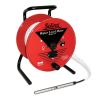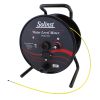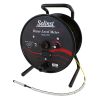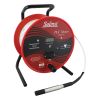Solinst Model 101B Water Level Meters
Features
- Very affordable, high quality Solinst product
- No buttons or controls to operate
- Rugged, corrosion-resistant components
- Free ground shipping
- Expedited repair and warranty service
- Lifetime technical support
- More
Basic Water Level Meter
The Solinst Model 101B Water Level Meter is designed to be an economical and basic, yet durable, instrument to measure groundwater levels. It is ideal for measuring depth to water in wells, boreholes, standpipes, and tanks. Also available from Solinst, are the Standard Model 101 Water Level Meters that feature a laser marked PVDF flat tape, and the Model 102 Coaxial Cable Water Level Meters. Both options allow shut-off and sensitivity adjustment.
Water Level Meter Operating Principles
The Model 101B Water Level Meter uses a solid stainless steel probe, connected to durable polyethylene flat tape. A standard 9 volt battery, housed inside the reel hub, powers the Water Level Meter. The electronics are coated for water resistance. When the probe enters water the electrical circuit is completed, sending a signal back to the reel where a light and clearly audible buzzer are activated. The water level is then determined by taking a reading directly from the tape at the top of the well casing or borehole.
Sturdy Reel and Handle
The Model 101B Water Level Meter has a sturdy frame and ergonomic handle for winding the tape. A brake is also included on the reel. The faceplate is easy to remove in order to access the 9 volt battery for replacement. For convenience, there is also a probe holder on the front of the faceplate.
Robust, Accurate Probe
The Model 101B P1 Probe is made from durable stainless steel. It is designed to reduce false signals in cascading water. The probe is extremely easy to replace.
Heat Embossed Polyethylene Flat Tape
The Model 101B Water Level Meter uses high quality polyethylene flat tape with accurate heat embossed markings every centimeter and meter. The 10mm (3/8") wide tape reels smoothly, remains flexible, hangs straight in the well and is available in 30m, 60m, and 100m lengths. Seven stranded stainless steel conductors resist corrosion, provide strength and are non-stretch. They make the tape very easy to repair and splice. The dog-bone design reduces adherence to wet surfaces.
In The News
Source Water Monitoring in Albany, New York: Tracing Water Quality throughout Tributaries
Thousands of US cities pull their drinking water from natural source waters like reservoirs, rivers, and streams, making overall watershed health a key consideration for water providers. In Albany, New York, the Albany Department of Water and Water Supply delivers drinking water to over 100,000 residents as well as monitors and manages the larger drinking water supply watershed. Hannah Doherty, Environmental Specialist at the Albany Department of Water and Water Supply , spends her days working with a small team to monitor the drinking supply and the connected water bodies. Doherty explains, “We’re the first to encounter the water that ends up being the drinking water.
Read MoreWildfire Prevention in the Sierra Nevada Region with the Yuba Watershed Institute
Though recent wildfires have sparked new conversations about wildfire management and response, groups like the Yuba Watershed Institute have been monitoring the forests and water resources of the Sierra Nevada region for decades, managing approximately 5,000 acres of land with the Bureau of Land Management (BLM) and about 7,000 acres in private land partnerships. The goal of the Institute is to work with local communities and land agencies to improve watershed and forestry management through informed practices and public outreach. The goals of the Yuba Watershed Institute are three-fold: Improve the ability of fire suppression agencies like the California Department of Forestry and Fire Protection ( CAL FIRE ) and the US Forest Service.
Read MoreWave Sensors Integration with NexSens Buoys: A Cutting-Edge Solution for Wave Measurment
Real-time wave data supports accurate weather prediction, safe and efficient maritime operations, and provides valuable safety and operating condition information for recreation and commercial fishing. Understanding wave dynamics also helps with the design of protective coastal structures like seawalls, breakwaters, and jetties. It also supports better prediction of their impact on sediment transport and coastal geomorphology. Wave data is a key factor in qualifying and designing offshore wind farms and harnessing kinetic energy for electrical generation. It helps with the understanding of ocean-atmosphere interactions and contributes to studies of sea-level rise and climate change impacts.
Read More



















